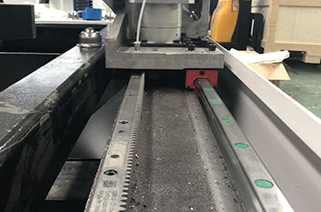
In the field of civil engineering, research on processing building materials with fiber metal laser cutting machine has been going on for 40 years, but the progress is very slow. The reason for this situation is that the processing cost of cheap fiber laser metal cut machine is too high. The requirements for laser output power in this field are too high, because under normal circumstances, concrete and other building materials are very thick and large. Since the late 1990s, the tremendous progress of several kilowatt-level lasers has reignited the enthusiasm for studying fiber laser machine table cutting processing building materials in the field of civil engineering. Below, we will briefly introduce the latest developments of fiber laser cutting machines in processing building materials, such as concrete, plaster plates and natural lasers, drilling and surface treatment.
Laser glazing: The technology of laser glazing natural stone and products was developed in the early 1990s. The glazed products are mainly used for wall panels. A defocused beam of low power density is used to melt the surface layer, and the color can be added to the layer by adding metal ions. In the case of natural stone, metal ions in the salt water can be applied to the surface of the product with a brush or other methods before laser treatment. In the case of cement products, a small amount of metal oxide powder can be added to the plaster or concrete mixture before casting. When the surface is melted by the laser, the glass layer is covered with a color corresponding to the metal ion or oxide. The advantage of laser glazing is that the pattern or color depth can be easily adjusted by changing the laser processing parameters.
Laser decontamination: Many countries are studying the feasibility of using laser to remove the surface of concrete fortifications and nuclear implementation of the ground pollution layer. Usually, pollution only exists near the surface, and the concrete below is not polluted. The removal of the contaminated surface layer (usually a few millimeters thick) will greatly reduce the volume of concrete to be processed when the nuclear facility is scrapped. The advantage of laser decontamination is that it is easy to realize remote operation, which can shorten the working time of workers in the contaminated area to the shortest, reduce the generation of secondary pollution waste, and reduce equipment pollution. Several available laser removal techniques include evaporation, spallation and thermal degradation.
The evaporation of the surface layer can be achieved by scanning the surface of the concrete with a focused high-power laser beam, but the power density must be high enough at this time, at least in the order of several kilowatts/cm2, and in the spalling process, only a non-focused laser is needed. Beam, the power density is low, about 200-300 watts/cm2. In the latter case, the water in the concrete below the surface evaporates instantaneously to produce internal stress, which can cause delamination and spallation of the surface layer. The disadvantage of using the cement spallation method to remove the surface layer is that this method is not stable and can only be used as the first operation step. Repeated scanning of the spalled area with the laser hardly produces further spalling. For this reason, this method is only effective for removing the shallow surface layer of 2-3 mm. The third method of removing the surface layer is to use a laser to melt and thermally degrade the concrete near the surface. The solidified glass layer and the thermally degraded layer below it are very fragile and easy to remove mechanically. The laser melting and mechanical removal process can be repeated until the removal thickness reaches the required thickness.
Surface roughening: The use of CO2 lasers to scratch and roughen the granite surface used in the building has been demonstrated in Japan more than ten years ago. People have tried to use it as a substitute for traditional methods. Compared with the flame roughening method, the advantage of laser scratching is that it will hardly damage the material under the surface, hardly affect the strength, and will not damage the edge of the stone.